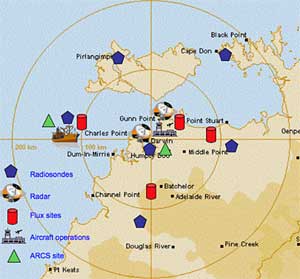Scientists Convene in Australia to Plan International Cloud Experiment
Published: 30 November 2004

Coming from as far away as Italy, Switzerland, and the United States, a 45 member team gathered in Darwin, Australia, in mid-November to discuss plans for an extensive field campaign scheduled to begin in early 2006. Key participants in the Tropical Warm Pool-International Cloud Experiment (TWP-ICE) currently include researchers from the U.S. Department of Energy’s Atmospheric Radiation Measurement (ARM) Program, the Australian Bureau of Meteorology (BOM), the National Aeronautics and Space Administration, the Commonwealth Scientific and Industrial Research Organization, the United Kingdom, and a group sponsored by the European Union. In addition, several United States, Australian, Canadian, and European universities are supporting the experiment. Both the Royal Australian Air Force (RAAF) and the Regional BOM Office, which will host the aircraft operations and be heavily involved in forecasting efforts, respectively, are enthusiastic supporters of the experiment.
Because of the extensive travel required to bring the team together, only a small number of planning meetings will occur. This week-long meeting was largely devoted to operational and logistics issues, with two afternoons devoted to breakout sessions for discussing aircraft, ground site, and forecasting activities. Another day was set aside for participants to tour the RAAF facilities, followed by a visit to the ARM Climate Research Facility site in Darwin. About 25 people from various backgrounds visited the site, which has hosted very few visitors because of its remote location. For many, it was their first visit to any ARM Climate Research Facility site, and provided the opportunity for a first hand introduction to the ARM science program. A smaller group of ARM and BOM researchers spent the last two days traveling to a number of the ground sites to collect information about the sites where staff will live while launching radiosondes during the experiment.
Tropical cirrus clouds have a large impact on their environment, but their dynamics and properties are poorly understood. Therefore, the experimental goal of TWP-ICE is to describe the properties of tropical cirrus and the convection that leads to their formation. To obtain this information, the experiment will take place in the region near Darwin during the Australian monsoon season (January-February). A crucial product from this experiment will be a unique data set of cloud properties and atmospheric state to provide the forcing and testing required by cloud resolving models and parameterizations in global climate models.
The ARM Climate Research Facility is a DOE Office of Science user facility. The ARM Facility is operated by nine DOE national laboratories, including .
Keep up with the Atmospheric Observer
Updates on ARM news, events, and opportunities delivered to your inbox
ARM User Profile
ARM welcomes users from all institutions and nations. A free ARM user account is needed to access ARM data.


















